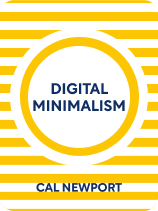

This article is an excerpt from the Shortform book guide to "Digital Minimalism" by Cal Newport. Shortform has the world's best summaries and analyses of books you should be reading.
Like this article? Sign up for a free trial here .
Who came up with the “attention economy” term? Do you think human attention can be considered an economic resource?
The term “attention economy” was coined by psychologist, economist, and Herbert A. Simon. The term is used to describe a business model in which advertisers pay publishers or platforms for access to people’s time and attention.
Keep reading to learn about the rise of the attention economy and some strategies that can help you resist its pull.
The Rise of the Attention Economy
The attention economy actually existed long before smartphones and tablets, but its current size and power is unprecedented. This business model traces back to 1830, with the publication of the first penny press newspaper, the New York Sun. Instead of printing high-quality stories and charging accordingly, the Sun’s publisher filled the paper with advertisements and mass-interest stories, and he dropped the price to just a penny. The business model was then adopted by tabloids, radio, television, and the internet. Then, iPhones and subsequent smartphones marked a significant turning point: Portable digital devices made it possible to grab consumers’ attention throughout the day, while the data they collected on consumers’ habits and preferences enabled advertisers to launch hyper-targeted ads.
Since tech companies have a vested interest in keeping you addicted to your devices, reclaiming control of your attention requires strong conviction and thorough planning. First, change how you view and use digital tools. Tech companies like Facebook present their products as foundational technologies (like electricity and cell phones) that you either use or you don’t—and, if you don’t, you’re an outlier.
Strategies for Reclaiming Your Time and Attention
Resisting the attention economy is a David-and-Goliath battle against tech companies’ efforts to keep your eyes glued to your screens. Here are some strategies to arm yourself for the fight:
1) Delete your social media apps. These apps are designed to be more addictive than the web versions, so the best way to disarm the attention economy’s most potent weapon is to delete the apps from your smartphone. When tech companies shifted their services to mobile apps, their influence and advertising revenues skyrocketed. Since apps proved to be a major money-maker, social media companies invested heavily in making them as addictive as possible. The swipe-down method of refreshing the newsfeed on Facebook’s mobile app was designed to increase user engagement because it plays into intermittent positive reinforcement. In addition to the addictive designs, social media apps are always with you when they’re on your smartphone, making it almost impossible to resist checking them when you have a few free moments while waiting in a lobby or standing in a checkout line.
The key to this advice is that you don’t have to stop using social media entirely—you just need to change the way you use them so that you have more control. Since you’ll have to log onto a computer to access those platforms, it will naturally limit how often you use them, and you’ll be more selective about when and why you log on. Many people who have tried this strategy changed the way they used social media: Instead of signing on frequently and scrolling aimlessly, they began using it briefly just a couple of times a week for specific uses. Other people stopped using social media, because the barrier of logging onto a computer for access outweighed the benefits.
2) Limit your smartphone’s capabilities. Block all distracting apps, websites, and functions on your digital devices, ideally by default or on a set schedule—for example, during work hours—and then unblock certain services when you need them. There are several digital tools that help you to create these blocks, such as Freedom and SelfControl. The goal is to turn your smartphone, tablet, or computer into a single-use device as much as possible.
When computers were first invented, it was the first time that a single machine could perform a wide variety of tasks, as opposed to something like a calculator that could do only calculations. Consumers valued the fact that computers allowed them to be more productive with just one piece of equipment. Over time, people began to use computers to perform multiple tasks all at once. However, switching back and forth among different apps and functions is less efficient than focusing on one task at a time—especially because those apps are designed to pull you into a time warp of distraction.
3) Use social media strategically. When it comes to being intentional about digital use, take a cue from social media professionals, such as marketing directors and social media strategists—they have to be smart about avoiding distractions, or they’d get nothing done. The best defense is a good offense. If you create a plan for using technology in a way that maximizes the benefits and minimizes the pitfalls, you’ll be better able to avoid distraction.
Consider the social media habits of one professional as examples of strategies you could use:
- Don’t rely on social media for entertainment—instead of sifting through Twitter to find articles and videos for entertainment, turn to sources like blogs and magazines that are dedicated to your interests.
- Use platforms like Instagram to follow a small number of accounts that reflect your interests, so that it’ll take you just a few minutes to browse updates.
- Avoid Instagram Stories, which add little value to Instagram posts but can eat up a lot of time.
- Keep your Facebook friend list as small as possible, limiting it to friends, family, and strategic exceptions.
- Create separate Twitter accounts for professional needs and personal interests, and follow only people who you feel are particularly knowledgeable and insightful.
4) Transition to “slow media.” The current digital landscape formed so quickly that most people adopted smartphones and social media apps without stopping to think about how to use these tools mindfully. However, it’s critical that people pause to consider their digital habits before diving even deeper into technological addiction. That’s the aim of the Slow Media movement, which encourages people to shift their media consumption to high-quality sources over convenient, low-quality media.
For example, let’s look at the slow media approach to news consumption. Many people get their news by checking social media and various news and aggregation sites throughout the day. One way to embrace slow media is to avoid breaking news, which is often redundant and sometimes incorrect. Instead, if you wait until the full article is published several hours later, you will get more accurate and complete information. In the same vein, make an effort to seek out opposing views on controversial stories. Additionally, limit your intake to only high-quality news by looking for stories by writers you respect. Finally, be intentional about how, when, and where you consume your news: You could start each day by reading the newspaper, and, whenever you come across longer pieces, set them aside for the weekend. Then, on Saturday morning, go to a coffee shop and read those articles without any distractions.
5) Get a “dumb” phone. Since smartphones are the most potent weapons in the attention economy, trading your smartphone for a cell phone that can only make calls and send texts is the most effective action you can take in resisting tech addiction and overuse. And, as tablets and laptops become lighter and more portable, getting rid of your smartphone is less radical than it seems. If you can’t completely ditch your smartphone because you need it for work or other logistical reasons, you could get a tethered dumb phone: When you want to have some time without your smartphone, activate your tethered phone to have texts and phone calls forwarded from your smartphone.
Conclusion
Just about every major innovation throughout history has raised concerns about how the new technology would change life and what the long-term consequences would be—that is as true of modern technology as it was with Morse code. But today, new technology is developing so quickly and providing such conveniences that most of us haven’t stopped to question whether we should use a technology just because we can.

———End of Preview———
Like what you just read? Read the rest of the world's best book summary and analysis of Cal Newport's "Digital Minimalism" at Shortform .
Here's what you'll find in our full Digital Minimalism summary :
- Why you're addicted to technology (and how tech companies feed your addictions)
- How a focus on social media is bad for real-life relationships
- How to transform your tech habits to get the best benefits without the drawbacks






